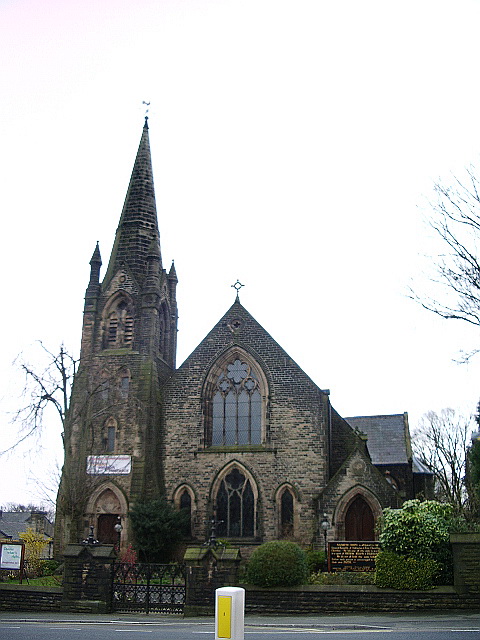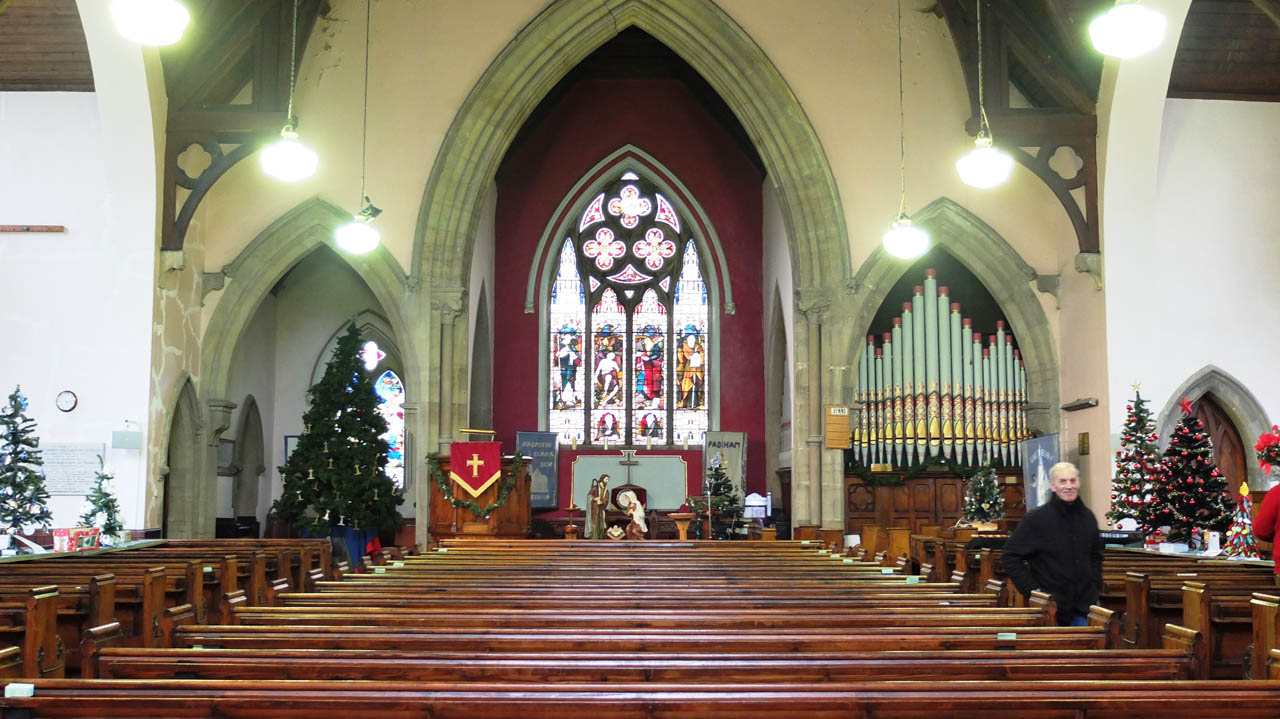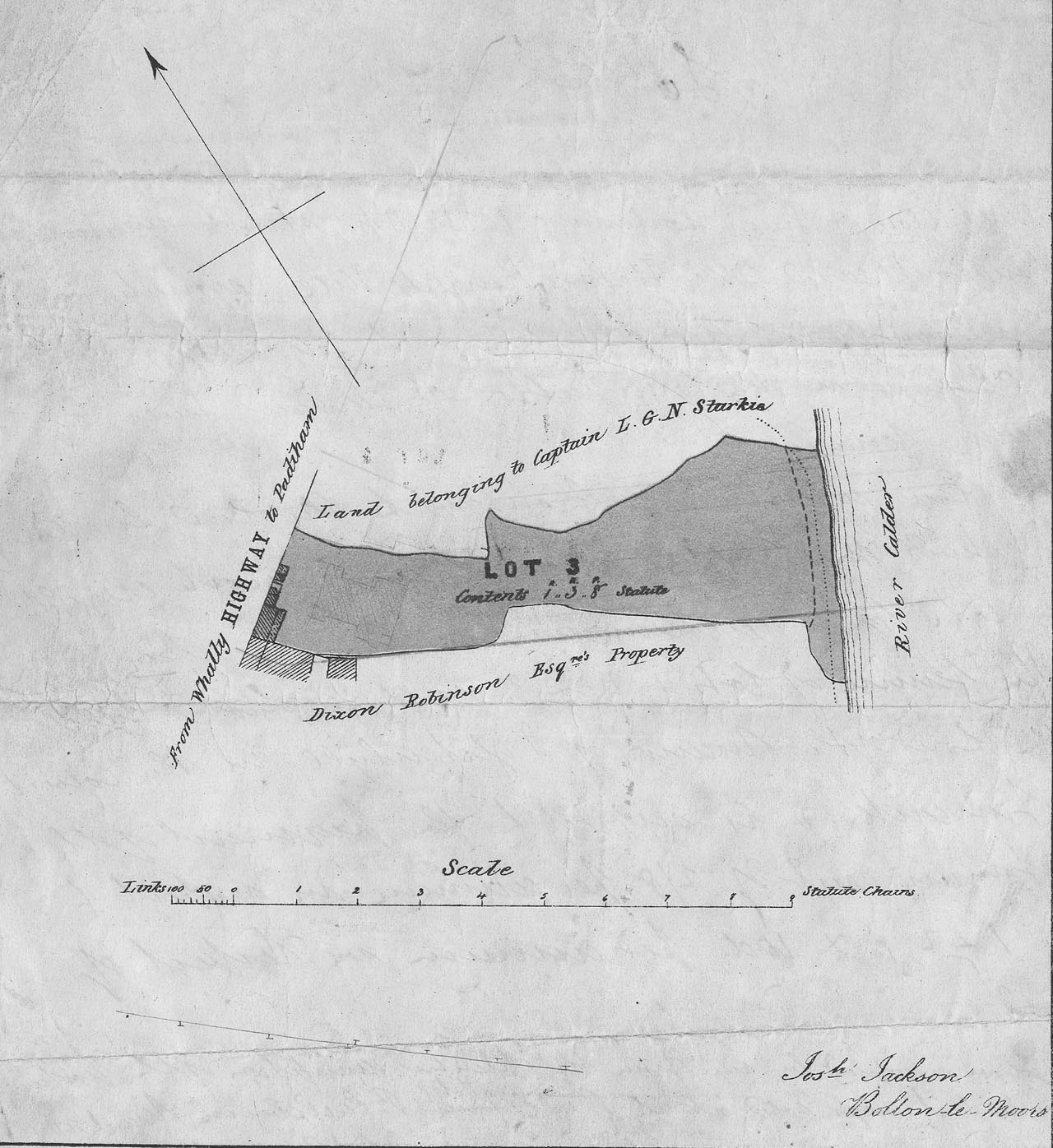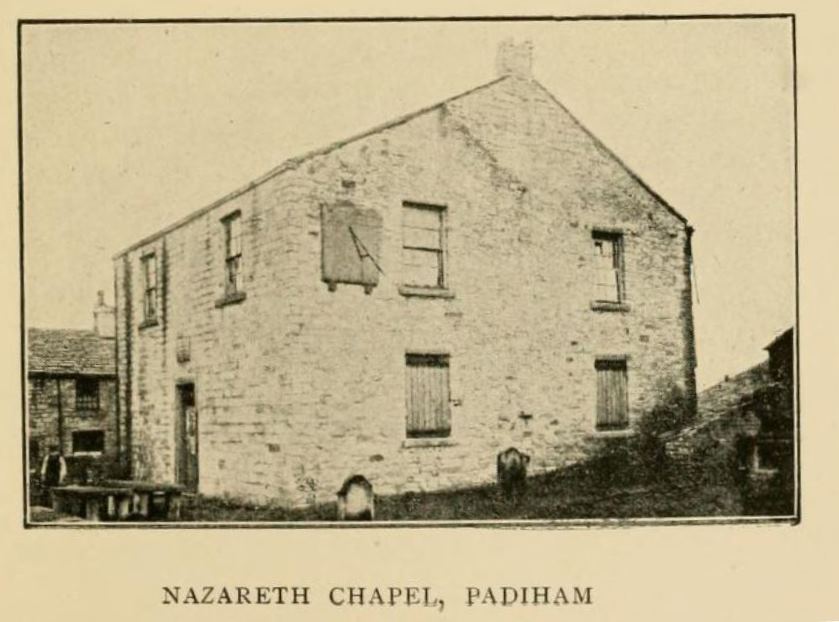 |
Nazareth Unitarian Chapel, Padiham |
 |
 Nazareth Unitarian Chapel, Padiham
Nazareth Unitarian Chapel, Padiham
|
Nazareth Unitarian Chapel is situated on Knight Hill at the junction of Blackburn Road and Church Street, Padiham. It was completed in 1874 at a cost of about £5000, replacing the original 50-year old church which had become too small and was in an inconspicuous position in a back street.
It was designed by Padiham architect Virgil Anderton (then in his early 20s) to be in the Gothic style, with a tower and octagonal spire reaching to about 100 feet. Inside there are no pillars to obstruct the view or sound. The masonry contract was awarded to his father Cornelius Anderton, a well-known local builder, who had also been the mason for the rebuilding of St. Leonard’s parish church in 1866-69. The Andertons, who were both members of the Unitarian congregation, provided their services for a nominal amount. Joinery work was by Eli Whitehead, also a member of the congregation.
The Grade II listed church was constructed on a sloping site from coursed sandstone and sandstone ashlar dressing, with a slate roof with gable copings. The Sunday School rooms are located both below the church and in a later extension to the basement. The wall piers and gates, again designed by Anderton, are also Grade II listed.
Below and behind the church was a sloping field, used for little apart from afternoon tea and games after the annual Whit Walk. However for those boys living fairly close by it was a convenient place in which to play football and cricket. It was eventually converted into a car-park in 1999.
 | |
Photograph supplied by and © of Ian Robinson |
Underneath the church there is a large room with a stage, compete with full-length curtains. A stage door gave convenient access from the pavement which slopes downhill at the side of the church. Several side-rooms were used as Sunday Schools. Two stairways led from the room up to the church. This large room was used for various social functions including the annual Sale of Work. It connected to a schoolroom extension that was built in 1904 which comprised a large room and several smaller rooms, including a kitchen, a Primary, and indoor toilets.
In 1888 a stained glass window was unveiled behind the altar in the chancel. It was the gift of Mrs. Eli Whitehead, whose husband had been responsible for the joinery in the church. At the bottom of the window are likenesses of the two men most responsible for bringing Unitarianism to Padiham, John Robinson and James Pollard, both of who died in 1848, and were buried in the old Unitarian Chapel’s graveyard. The gravestone of John Robinson and his wife was later moved to the new church and currently lies besides a rear wall. It reads:-
|
|
A splendid electronic organ made by Phoenix Organs was installed in 2004, that replaced the old (1881) pipe organ that the author remembers had an electric blower and also a backup lever for the manual bellows, if required. The original organ pipes are no longer used but remain on view, beautifully decorated with a design scaled to the size of each pipe, and highlighted with gold-leaf.
|
|
The church was built on plot of land, the purchase of which in 1867 is of considerable interest.
Opposition to the Unitarians’ beliefs existed throughout the early 19th century and still existed in the late 1860s when land for a new Nazareth Chapel was being sought, but local land-owners refused to rent their land for this purpose. However, using a neat stratagem in the face of this sectarian prejudice suitable land was bought at auction for £420, where the chapel could be built in a more prominent position than before. This was Lot 3, auctioned at the Bull Hotel Blackburn, Wednesday 20 March 1867.
 | |
Image Courtesy of Tony Cann of Padiham Unitarian Church |
 | |
Image Courtesy of Tony Cann of Padiham Unitarian Church |
Transcribed below is an extract from a document of about 1877 written by the chapel secretary Nicholas Bridge, which gives us some idea of the prejudices of land-owners towards the Unitarians, then explains how the land was obtained anonymously at the auction:-
|
Negotiations were entered into with the late Le Gendre Nicholas Starkie, Esquire, and if I am informed right his reason for objecting to let his land for the purpose of building a Unitarian Chapel, were this: that it was against his principles to draw rent from any religious body, still at the same time he could not afford to give them a piece of land. After that Sir James Kay-Shuttleworth, Bart., was treated with, but what his reasons were I am not prepared to say, but suffice it to say that he also objected to let them have a piece of land for that purpose. After all this had taken place the matter rested for a time, until a Sale by Auction was advertised to take place at Blackburn. The committee at once resolved to purchase one of these plots, then the question arose how were they to purchase it without it being known that it was being bought by the Unitarians of Padiham. “Feeling at that day was very strong against them”. However they hit on a plan which succeeded, they secured the services of a gentleman, who was well known to all, and previous to him leaving Padiham to reside at Nelson, he was a member of the congregation, they got him to bid for them at the sale, “and if I am not mistaken some members of the committee were there throwing dust on other peoples’ eyes” by bidding now and again against the man who were [sic] buying the land for them, however he ultimately became the purchaser, and as soon as it was made known that he had bought it for the Unitarians of Padiham, parties there, said that had they known who the gentleman was buying for, he should not have had it for three times the amount, and as soon as the news reached Padiham that the land had been bought, a flag was procured and hoisted on the Old Chapel to let the opposition party see that we had won the victory and secured a piece of land on which to build a Unitarian Chapel. |
The purchaser was Thomas Holland, acting as agent for people from the Unitarian Church, namely David Harrison (Gardener), Henry Holland (Grocer) and Robert Kershaw (Grocer).
 | |
from "The Methodist Unitarian Movement" by H McLachlan 1919 |
The Unitarian Methodists held their first meetings in a cottage situated in Back Lane (now East Street) from about 1806 until their first chapel, now known as the Old Nazareth Chapel, was built in 1822/3 on a site at Old Spring Gardens, opposite 34-50 West Street.
In the 1820s, there was a lot of opposition by Wesleyan Methodists to the Unitarians and the proposed chapel building, and opponents began buying up all suitable plots of land to thwart them, but eventually a plot was procured and building started in 1821, with the congregation digging the foundations themselves. The site had previously been the location of the original Wesleyan meeting house, a thatched cottage built about 1748. During the construction of the chapel, opponents continued to interfere with its construction, even extending to pulling down by night work done during the day.
Completed in 1823, the Unitarians opened their new meeting house, which they called Nazareth Chapel. Above the door at the entrance was a stone with the following inscription on it :—
The cost of the Old Nazareth Chapel was £419–16–6 and the amount raised by the congregation towards this sum was £31–10–0. Stone stairs were built into the walls of the chapel in preparation for the galleries added in 1836. Land adjoining the chapel was also acquired for a burial ground, and a sundial with the date 1836 and the inscription "Believe every day may be the last" was fixed onto the chapel wall. Two years later an organ was purchased by the Padiham congregation for the sum of £20, from the Bury Unitarian congregation.
The Sunday School attracted many who were above the age of children, so great was the zeal for knowledge amongst their members. In 1828 at Padiham many married men had become scholars and were learning to read and write, whilst the number of scholars ready to enter the school was beyond its capacity to hold them.
This old chapel closed in 1874 when the current Nazareth Unitarian Church was consecrated. In 1899 it was renovated for intended use as a kind of Unitarian mission room, but it is not clear how long that lasted. The old building was then mainly used for various industrial purposes including the production of firelighters, as a silk size and paste factory, and the manufacture of bleach, up until the 1970s, when it was used as a builder’s store.
The building was demolished in the 1990s and the site redeveloped for a private house.
With grateful thanks to Tony Cann of Padiham Unitarian Church for allowing us access to historical documents relating to the church.
Ian Robinson (April 2015)
| Padiham Home & Contents | ©Lancashire OnLine Parish Clerks | Lancashire Home |